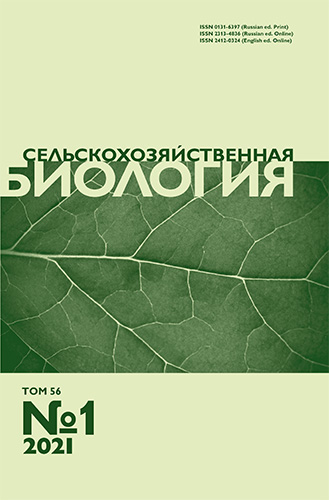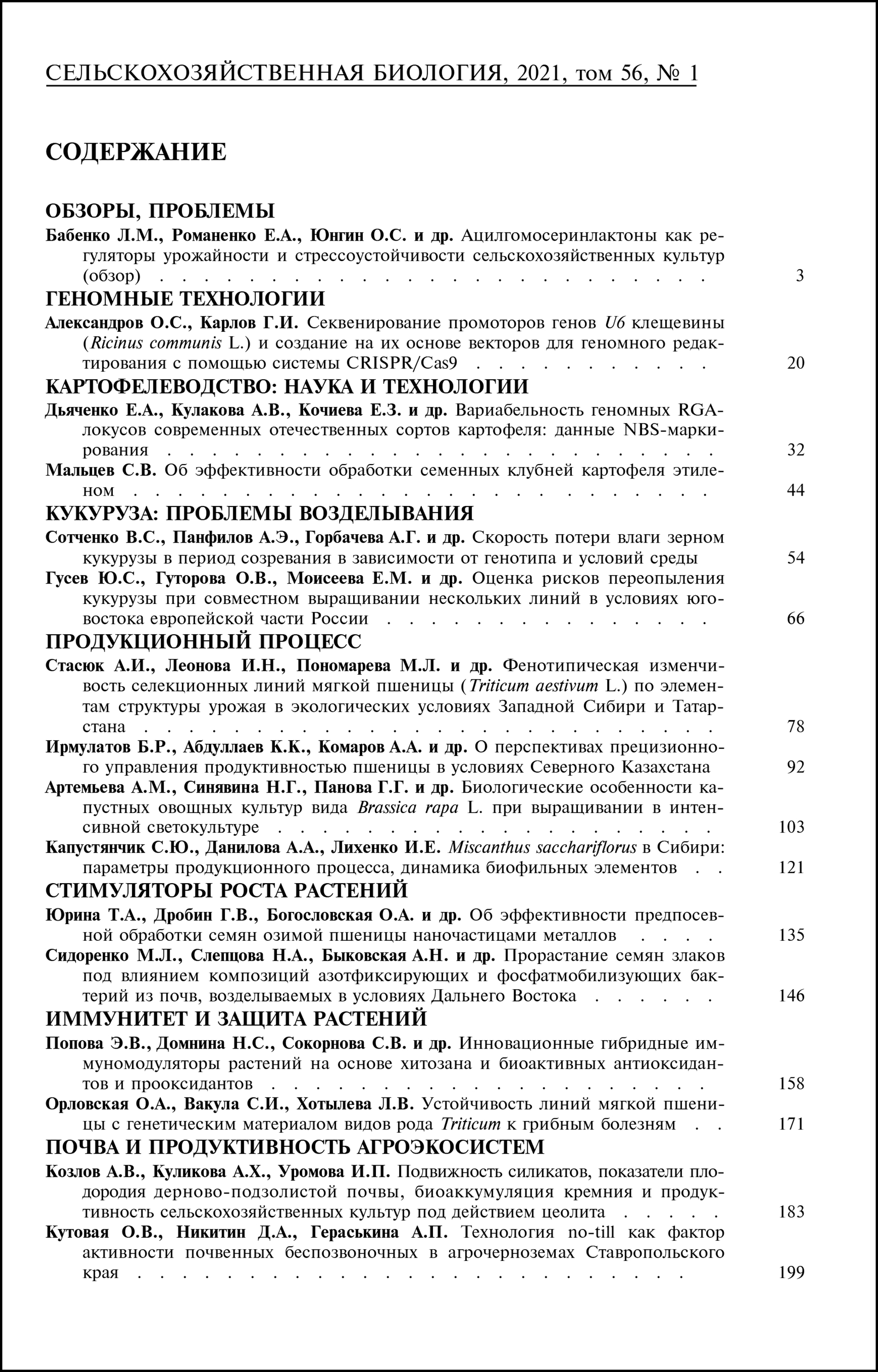doi: 10.15389/agrobiology.2021.1.54rus
УДК 633.15:581.14:577.1:57.042
СКОРОСТЬ ПОТЕРИ ВЛАГИ ЗЕРНОМ КУКУРУЗЫ В ПЕРИОД СОЗРЕВАНИЯ В ЗАВИСИМОСТИ ОТ ГЕНОТИПА И УСЛОВИЙ СРЕДЫ
В.С. СОТЧЕНКО1, А.Э. ПАНФИЛОВ2 ✉, А.Г. ГОРБАЧЕВА1,
Н.И. КАЗАКОВА2, И.А. ВЕТОШКИНА1
Высокая влажность зерна при уборке — один из факторов, сдерживающих расширение посевов кукурузы (Zea mays L.) в Уральском регионе. Снижение уборочной влажности семян достигается селекцией кукурузы на скороспелость (раннее цветение початка) и на ускоренную потерю влаги зерном в предуборочный период. В нашем исследовании впервые установлено, что в условиях юга России на фоне погодных условий, слабо лимитирующих процесс потери влаги зерном кукурузы, его уборочная влажность обусловлена скоростью влагоотдачи в предуборочный период, тогда как в Уральском регионе на периодически неблагоприятном фоне — главным образом скороспелостью изученных гибридов. Цель работы — выявление гибридов кукурузы с повышенной скоростью потери влаги в период созревания зерна и оценка проявления этого признака на неблагоприятном гидротермическом фоне. Исследования проводили в 2016-2018 годах в двух контрастных географических пунктах — в предгорной зоне Северного Кавказа (опытное поле Всероссийского НИИ кукурузы, п. Пятигорский, Предгорный р-н, Ставропольский край) и в северной лесостепи Южного Урала (Южно-Уральский ГАУ, с. Миасское, Красноармейский р-н, Челябинская обл.) — на шести ультраранних гибридах кукурузы (Zea mays L.) Нур, Росс 130 МВ, Обский 140 СВ, Кубанский 141 СВ, Машук 150 МВ, Уральский 150 и раннеспелом Биляр 160. Полевой опыт был заложен в 3-кратной повторности методом организованных повторений с рандомизированным размещением вариантов. Регистрировали фазы всходов, цветения початка и физиологической спелости зерна, о наступлении которой судили по появлению темного слоя у основания зерна. Наблюдения за влажностью зерна на Северном Кавказе проводили с 25 июля по 11 сентября, на Южном Урале — с 15 августа по 10 октября. Влажность зерна определяли гравиметрическим методом. Образцы массой не менее 70 г высушивали при температуре 150 °С (сушильный шкаф SNOL 58/350, «Elektrotechnika, AB», Литовская Республика) до постоянной массы (ее определяли с использованием электронных весов CAS MW-II, «CAS Corporation», Республика Корея). Для анализа отбирали и полностью обмолачивали средние образцы початков массой от 1,2 до 1,8 кг по 10 шт. в трех повторениях. Периодический отбор проб зерна проводили с интервалом в 3-7 сут, что обеспечивало от 8 до 16 контрольных точек. Проверку статистических гипотез осуществляли методами дисперсионного, корреляционного и регрессионного анализа. Установлено, что календарные сроки цветения початка в северном пункте исследований отмечаются на 22-36 сут позднее, чем на юге страны, и приходятся на начало или конец III декады июля. В условиях Северного Кавказа цветение наблюдалось в III декаде июня—начале июля, зерно достигало физиологической спелости в период с 1 по 7 августа, а процессы созревания и налива ультраранних гибридов проходили на благоприятном гидротермическом фоне. Следовательно, условия среды не ограничивали скорость потери влаги зерном, что обеспечило объективную оценку различий между гибридами по исследуемому признаку. Были выявлены существенные различия по скорости влагоотдачи как между пунктами исследований, так и между изученными гибридами. В Северо-Кавказском регионе скорость потери влаги зерном после достижения физиологической спелости колебалась по гибридам от 0,63 до 0,78 %/сут при слабом варьировании по годам. В Уральском регионе на фоне высокой относительной влажности и низкой температуры воздуха в предуборочный период скорость влагоотдачи снижалась до 0,21-0,35 %/сут, а в благоприятных гидротермических условиях достигала лишь 0,52-0,72 %/сут. Установлено, что уборочная влажность зерна кукурузы связана с двумя основными признаками гибридов: скороспелостью и способностью к быстрой потере влаги на заключительных этапах онтогенеза. Вклад каждого из этих признаков определяется условиями созревания зерна: для юга России влажность зерна в значительной степени определяется способностью гибрида к ускоренной влагоотдаче, в условиях Южного Урала основное значение имеет раннее цветение початка. Различия между гибридами по скорости потери влаги в этих условиях проявляются нерегулярно и зачастую нивелируются влиянием среды. Следовательно, для северной зоны кукурузосеяния селекция кукурузы на способность к быстрой потере влаги зерном имеет смысл лишь в сочетании с отбором на короткий вегетационный период, который должен рассматриваться как приоритетный признак при создании адаптированных гибридов.
Ключевые слова: кукуруза, ультраранние гибриды, онтогенез, вегетационный период, влажность зерна, скорость влагоотдачи, Южный Урал, Северный Кавказ.
GENOTYPE AND ENVIRONMENT INFLUENCE ON THE RATE OF GRAIN MOISTURE LOSS IN CORN DURING RIPENING PERIOD
V.S. Sotchenko1, A.E. Panfilov2 ✉, A.G. Gorbacheva1, N.I. Kazakova2,
I.A. Vetoshkina1
High grain moisture during harvesting is a factor that restrains the expansion of corn (Zea mays L.) crops in the Ural region. A decrease in the harvesting moisture content of seeds is achieved by corn breeding for early maturity (early flowering of the ear) and for accelerated moisture loss from grain in the pre-harvesting period. In our study, it was found for the first time that in the conditions of southern Russia under weather conditions that weakly limit moisture losses, the harvesting moisture of corn grain is determined by the rate of pre-harvesting moisture losses while in the Ural region where the weather conditions are periodically unfavorable the moisture losses are mainly due to the early maturity of the studied hybrids. This work aims to identify corn hybrids with an increased rate of moisture loss during grain ripening and to assess this trait under unfavorable hydrothermal conditions. The studies were carried out in 2016-2018 in two contrasting geographical sites, in the foothill zone of the North Caucasus (experimental field of the All-Russian Research Institute of Corn, the settlement Pyatigorskiy, Predgornii District of the Stavropol Territory) and in the northern forest-steppe of the Southern Urals (South Ural GAU, village Miasskoye, Krasnoarmeyskiy District, the Chelyabinsk Province). Six ultra-early corn hybrids (Zea mays L.) Nur, Ross 130 MV, Obsky 140 SV, Kubansky 141 SV, Mashuk 150 MV, Uralskiy 150 and early ripening Bilyar 160 hybrid were involved in the study. The field experiment was arranged in triplicate using a randomized field plot layout (28 m2 plots with a full set of hybrids per plot). The recorded phenological phases were germination, ear flowering and physiological ripeness of grain detected by the corn kernel “black layer” as an indicator of physiological maturity. The corn grain moisture was measured gravimetrically from July 25 to September 11 in the North Caucasus and from August 15 to October 10 in the South Urals. Samples weighting not less than 70 g were dried at 150 °С to a constant weight (a SNOL 58/350 exicator, Elektrotechnika, AB, Republic of Lithuania; a CAS MW-II electronic Weighing Scale, CAS Corporation, Republic of Korea). For analysis, 10 ears of 1.2 to 1.8 kg were collected and completely threshed in three reps. Grain sampling was carried out with a 3-7-day intervals providing 8 to 16 control points. Statistical hypotheses were tested by methods of variance, correlation and regression analysis. It was found that in the northern site, the calendar dates of flowering of the ear occurred in the beginning or end of the third decade of July, that is, 22-36 days later than in the south site. In the conditions of the North Caucasus, flowering occurred in the third decade of June—early July, the grain physiological ripeness was reached from 1 to 7 August, that is, grain maturation and filling in ultra-early maturing hybrids occurred under favorable hydrothermal conditions. Consequently, environmental conditions did not limit the rate of moisture loss in grain, which provided reliable estimates of the differences between hybrids according to the trait. The research revealed significant differences in the rate of moisture loss both between the study sites and the hybrids. In the North Caucasian region, the rate of moisture loss in grain after reaching physiological ripeness varied for hybrids from 0.63 to 0.78 % per day with slight variation over the years. Under higher relative humidity and low air temperature the likelihood of which in the pre-harvest period is high for the Ural region, the rate of moisture loss decreased to 0.21-0.35 % per day, and under favorable hydrothermal conditions it reached only 0.52-0.72 % per day. It has been established that the harvest moisture content of corn grain is associated with two main characteristics of hybrids, i.e., the early maturity and the ability to quickly lose moisture at the final stages of ontogenesis. The contribution of each factor is due to the conditions of grain ripening. I.e., for the south of Russia, grain moisture is largely due to the ability of a hybrid to accelerate moisture losses. On the contrary, in the conditions of the Southern Urals, the early flowering of the ear is of primary importance. Differences between hybrids in the rate of moisture loss under these conditions appear irregularly and are often leveled by the influence of the environment. Therefore, for the northern zone of corn sowing, the corn breeding for its ability to rapidly lose moisture from grain makes sense only in combination with breeding for a short growing season which should be considered as a priority trait when creating adapted hybrids.
Keywords: corn, hybrids, ultra-early maturity, ontogenesis, vegetation period, grain moisture, moisture loss rate, Southern Urals, Northern Caucasus.
1ФГБНУ Всероссийский НИИ кукурузы, |
Поступила в редакцию |












